Archived Storm Damage Blog Posts
Be Prepared for Helene
9/24/2024 (Permalink)
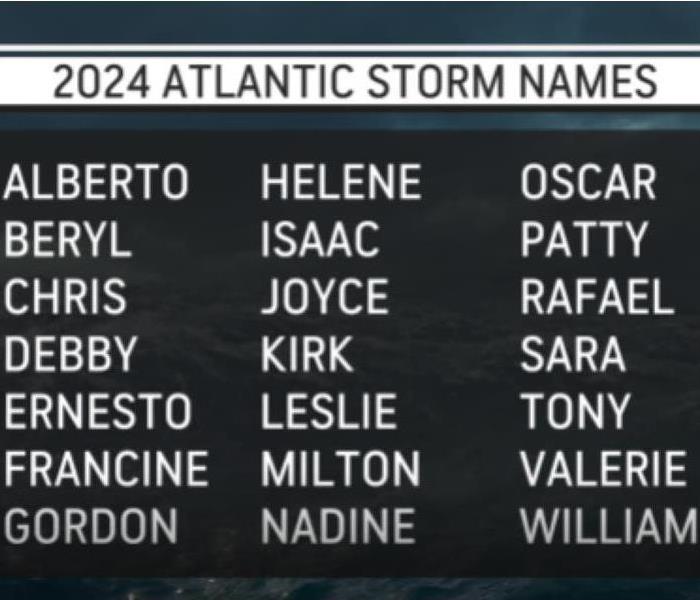 Hurricane Helene will be our next named storm.
Hurricane Helene will be our next named storm.
Knowing a storm is coming can cause anxiety among other things. The best thing you can do is be prepared for it or secure your home/business and evacuate. With Hurricane Helene possibly heading towards Florida get prepared now before it makes landfall.
Clay County has many resources to help you with that preparation. Utilize their lists and downloadable apps to keep up with new area alerts for our community.
If and when your home or business has any storm damage you can reach us at 904-861-8870 to get services lined up. Keep in mind if you have rising water into your home and it has not receded we cannot come and extract water if it is still coming into your home and we cannot get our vans close enough if it is still extremely flooded around your home. Just a few things to keep in mind when determining if it is time to call SERVPRO® yet or wait.
We are available 24 hours a day, 7 days a week and will do our best to have someone onsite to assess damage quickly. We also verify coverage if you have insurance and if it is self pay we will give you an onsite verbal estimate. Once services commence we will measure the areas effected, scope the actual work performed and put into an estimating system to provide a written report of all services rendered.
Hoping this helps with preparing for Hurricane Helene and maybe, just maybe it will head more west!
Flood Prevention Tips During Hurricane Season | SERVPRO of North Clay County/Oakleaf/Middleburg
8/15/2024 (Permalink)
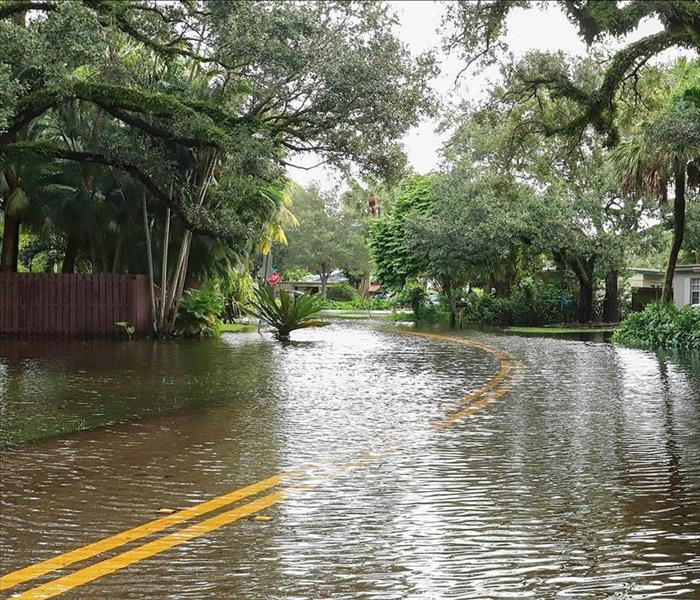 In case of severe flooding due to storms, our team SERVPRO of North Clay County/Oakleaf/Middleburg is always ready to help.
In case of severe flooding due to storms, our team SERVPRO of North Clay County/Oakleaf/Middleburg is always ready to help.
The threat of storms is a constant concern for our community, regardless of the season. Whether due to strong summer storms, sudden downpours, or coastal storms and hurricanes, these weather events can cause significant damage and serious flooding issues.
Although it’s impossible to prevent storms, there are steps you can take to safeguard yourself and your home from potential danger or harm before, during and after a storm.
Before the Rain Starts to Fall
You should always be informed of the forecast, even if the day starts out sunny! This way, you can start preparing your home as soon as a weather alert is issued.
We will often have a little bit of preparation time before storms hit, especially hurricanes, so taking advantage of every minute is crucial to your preparation. Start by cleaning up your yard and removing any hazards that could potentially be swept away by fast-moving water. Tie down anything that can’t easily be moved, such as grills, patio furniture or trampolines.
This is also the perfect time to look at your gutter system. Check to be sure that your downspouts are secured and pointed away from your home. If you have any sand bags that you can put around your property, now is the time to do this important step as well. Once inside, close all windows and doors, lock your storm shutters and hang tight inside until the threat has passed.
During the Storm
If you have decided to stay rather than evacuate based on the particular storm, it is imperative that you keep a close eye on the forecast. Stay inside and choose a sheltering location based on whether a severe storm is passing through or a hurricane is making landfall.
In either case, be sure to gather up your emergency kit, comfortable clothes and bedding, and any necessary medications or other accommodations that your family may need while you wait out the storm.
After the Storm Has Passed
Depending on the path of the storm, you could be left to deal with some pretty significant structural and flooding damage to your home. Water can easily overwhelm our dry ground and can lead to flash flood situations that can infiltrate your home’s lowest levels. Use extreme caution walking around after the storm, and do your best to avoid walking through any standing water in your home.
Floodwater can quickly pick up dangerous substances like toxic chemicals, or it can be harboring sharp objects just below the waterline. Wear weatherproof boots if you must walk through the water to get to safety.
Our team for restoring storm and flood damage will be prompt in arriving to secure your home and start working. We will immediately remove excess water and begin the necessary repairs.
Our primary objective is to restore your home to its original condition as soon as possible—and in the most effective way. Count on us during disasters, and we will provide you with the necessary assistance.
Strong storms can lead to serious flooding issues. Our team at SERVPRO of North Clay County/Oakleaf/Middleburg can help you recover.
How Technology is Valuable during a Hurricane
9/28/2022 (Permalink)
 Technology is important during a Hurricane
Technology is important during a Hurricane
While the idea of technology seems simple on the outside, the constant updates and innovations can deter people from learning all that their devices can do for them. When emergencies or natural disasters hit close to home, it can be extremely advantageous to know how to make the best use of your technological devices. Technology allows you to stay updated on outside conditions as well as let family and friends know where you are.
We recommend keeping portable chargers readily accessible so that you can make the most of your technology during an emergency. Keep these tips on how to effectively use your devices in mind.
Applications for News Updates
Checking apps for updates on your smartphone is a fast and easy way to catch up with the latest news in North Clay County to include western Orange Park, North Middleburg, Oakleaf and areas around Black Creek. Make sure you have reliable news apps downloaded before inclement weather hits so that you can stay posted on local weather conditions and national updates.
Mark Yourself Safe
Another helpful feature of social media that not a lot of people know to use is the ability to mark yourself as safe. Facebook offers a feature called Safety Check that lets users mark themselves as safe if there is a dangerous situation in or near where you live. Simply updating your status as safe lets family and friends know that for the time being, you are out of harm’s way. The Red Cross has a similar feature called Safe & Well, which is both an app and website, where users can be marked safe.
Use Online Storage
Websites like Google Drive and DropBox ease the stress of possibly losing important copies of identification cards, passports, insurance policies, medical records, pet records, etc. in the event of a disaster. Be sure to scan and save any important documents before inclement weather is expected.
Make SERVPRO of North Clay County/Oakleaf/North Middleburg your go-to team when your home or business in is in need of any kind of remediation. Call us today at (904) 861-8870.
Prepare for Heavy Rain - The Correct Way
6/22/2022 (Permalink)
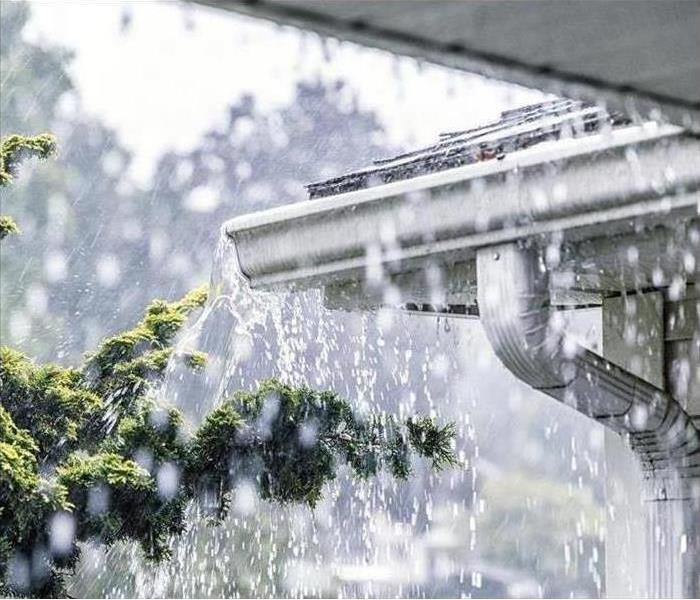 Rain Heavily Falling and Gutters Overflowing with Rain Water
Rain Heavily Falling and Gutters Overflowing with Rain Water
Living in Florida there is always that chance of heavy rain storms coming our way. SERVPRO of North Clay County / Oakleaf / North Middleburg has worked on multiple projects that were due to the surplus of rain. The most memorable one being 2012 during Tropical Storm Debbie. With almost 30 inches of rain in a short time we had several people call us at all hours of the day and night due to leaks caused by the rain. Sometimes these leaks are unavoidable, but we want to make sure you are prepared for the next storm.
There are various forms of getting prepared for rainy weather but for the most part normal maintenance will keep your home or business safe from heavy rain.
Here are some tips to avoid rain damage.
- Plant shade trees or palm trees at least 20 feet away from your home.
- If you have gutters, make sure they are clean.
- Ensure there are no leaks on your roof.
- Check for damage on your home or business and repairs are needed.
- Weatherstrip windows and doors.
- Have your trees trimmed.
Hurricane Names for 2022
6/21/2022 (Permalink)
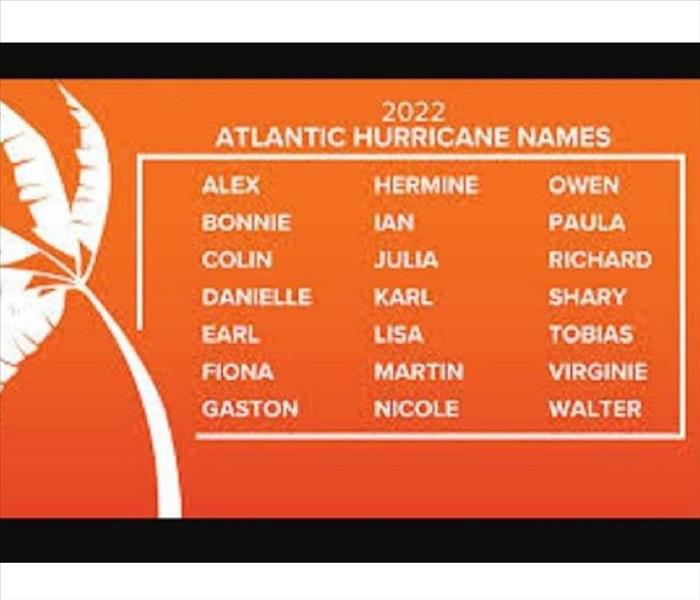 2022 - Are You Ready
2022 - Are You Ready
The 2022 hurricane season is underway and the first named storm of the season is now behind us. Although tropical systems can form in any month of the year (and they have), the official hurricane season for the Atlantic basin runs from June 1 to November 30.
Tropical storms and hurricanes are named via a 6-year rotating list, standardized by the World Meteorological Organization. Representatives from hurricane-prone nations contribute names for the lists, which alternate between male and female. The letters Q, U, X, Y, and Z are not used.
There have been two changes to the list since 2016. Matthew was retired after causing almost 600 deaths and over $16 billion in damages. It has been replaced by Martin in the 2022 list. Otto caused substantial damage in Central America in November 2016, and will be replaced by Owen in 2022 and beyond.
If a hurricane season turns hyperactive with more than 21 named storms, the National Hurricane Center will then proceed to a supplemental list of names.
NOAA is expecting between 14 to 21 named storms with six to 10 hurricanes. Of those hurricanes, they anticipate three to six will become major hurricanes. CSU’s outlook predicts 20 named storms including 10 hurricanes, five of which they expect to be major hurricanes.
Those of us living in North Florida always are hopeful for a quiet hurricane season and when we do have one coming are normally well prepared. For those of you new to Florida see a prior blog of ours about hurricane preparedness.
Our office, located in Orange Park, Florida in North Clay County is Here and Ready to Help if your home or business experience any damage. We are 24 / 7 / 365 available for emergency services. You can reach us at 904-861-8870. Areas of service are North Middleburg, Oakleaf, Orange Park and a small portion of Jacksonville.
Here to Help
6/17/2022 (Permalink)
 SERVPRO's work together to help communities recover after a storm
SERVPRO's work together to help communities recover after a storm
SERVPRO'S from surrounding areas head in from all over to help the in areas that have been affected by inclement weather. SERVPRO is a team oriented company that has compassion for everything we do and everyone we help. When another area of the country is impacted with a storm or tragedy we can call upon our fellow teammates to come in and help. Sometimes due to the area being affected it may require out of state SERVPRO's to respond in a time of need. We have traveled to Pennsylvania, Michigan, Texas, Louisiana just to name a few and continue to be ready for the call when we are needed. The goal is to assist our fellow SERVPRO's and treat all customers with the best customer service experience as one, unified company. After all was said and done, all the help of these surrounding SERVPRO's were able to team up together and restore this broken community.
Are you Prepared for Hurricane Season
6/2/2022 (Permalink)
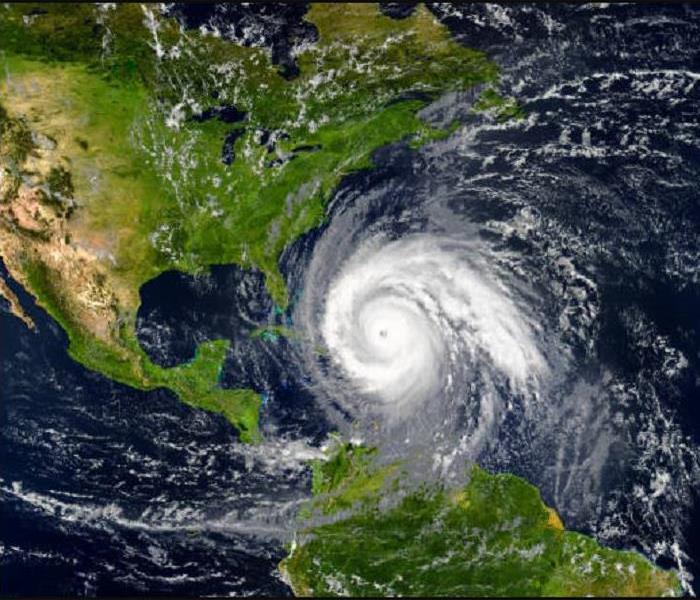 Disaster Supply Kit Checklist
Disaster Supply Kit Checklist
Here at SERVPRO we are prepared and ready for whatever happens! To assist your family or business in being prepared we recommend you have a preparedness plan. FloridaDisaster.org recommends the attached list of items to include in your plan.
Here in Clay County we have low lying areas and we have Black Creek, that is prone to flooding. Being prepared for overflowing water is a must. When something such as a hurricane is headed our way, Clay County has areas designated to offer sand bags to assist in your efforts to keep things from flood water intrusion.
Along with these tips, there are evacuation routes per zone (residential and commercial) and you can find those here.
If there is anything SERPVRO of North Clay County/Oakleaf/North Middleburg can do to assist you please feel free to call. Advice is always free!
What to Do After Storm Damage, Repairs, Tips
7/1/2021 (Permalink)
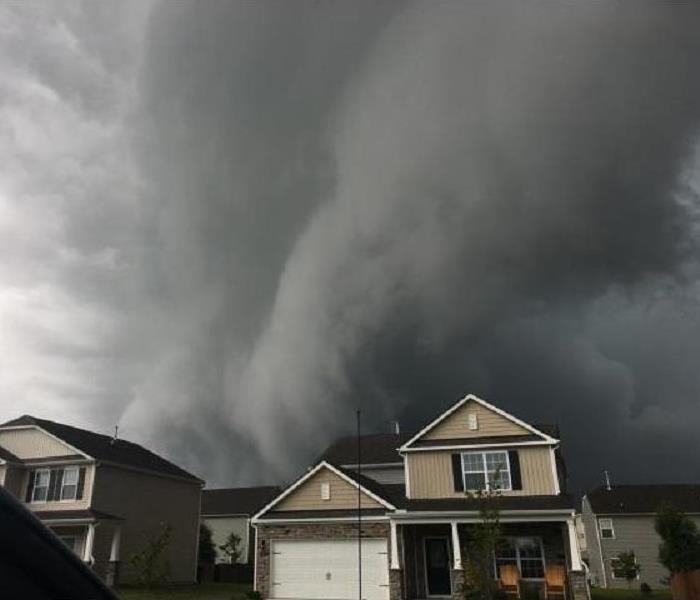 What to Do After Storm Damage, Repairs, Tips
What to Do After Storm Damage, Repairs, Tips
Knowing the right steps to take after storm damage can go a long way toward protecting you and your family, as well as your property and finances, from risks of further loss. As challenging as storms can be, learning the steps to take before a storm comes through and turns your life upside down will arm you with the knowledge you need to stay prepared. Here are some tips from the restoration and cleanup specialists at SERVPRO of Columbia & Suwannee Counties.
Five Things to Do After Storm Damage
You can mitigate some of the damage caused by a storm by following this checklist:
1. Check your home for damage.
While not all storm damage will be apparent immediately after the storm has passed, checking your home's condition will give you a clearer picture of the extent of the damage left by the storm.
SERVPRO of Columbia & Suwannee's experts provide a word of caution to take all the necessary safety precautions when checking your home since unexpected damage may cause injuries. Watch out for loose or exposed ceiling tiles or floorboards, broken electrical lines, and slippery floors. Fortunately, some safety tips can help:
- Avoid standing water
- Avoid checking for storm damage in the dark.
- Watch out for exposed nails, window damage, collapsed walls and roofing materials, and broken glass
- Switch off the electricity and shut off the main gas line before entering a damaged home
2. Assess the potential damage
During a storm, some areas in a home are more susceptible to damage than others. One site that is often vulnerable is the roof. Common signs of roof damage include:
- Split seams
- Dented, missing, or broken shingles
- Holes in the roof
- Leaks in the ceiling or roof
Other areas that are susceptible to storm damage include doors and windows. Inspect all windows for damaged frames, broken panes, cracks, and holes. Remember to board up any broken windows.
Also, assess your home's exterior, looking for damage such as dents, holes, cracks, and chipping to any brickwork, paint, or siding. The storm could have also damaged outdoor appliances such as air conditioning units.
Taking all the necessary precaution, be sure to remove debris from the gutters and roof, and then check that the downspouts are intact and unobstructed so they can continue diverting water away from your home. Remember to check for mold, which is common after flood damage.
3. Get in touch with your insurance carrier.
Document the damage and loss that has been caused by the storm, taking photos before removing or moving any objects or debris. Remember to document any additional costs incurred due to the loss, such as hotel receipts or other temporary living costs.
Once all this information is together, contact the insurance provider to determine whether your insurance plan covers the damage caused. Likewise, inquire about the steps to take to make a claim.
4. Attend only to the damage you are capable of handling.
In some cases, the storm might not have caused extensive damage, and you may be able to restore what little damage exists with a few repairs before seeking professional repair services. Prompt repairs can go a long way toward limiting the damage.
If that's the case, you should begin with what you can fix yourself, taking care not to cause additional damage. For example, if wind and water are getting into your home through a broken window, board it up as soon as possible. However, if you're not confident in your repair skills, it's best to get in touch with a company that can offer emergency repair services.
5. Choose the right contractor.
The next step is to hire a professional and trustworthy cleaning and restoration service company to restore your home to its former glory. Choosing a contractor that will promptly attend to your home's restoration, take care of water damage, and immediately mitigate the presence of potential mold is critical.
It's essential to ensure that your house is once again a habitable, healthy living environment. That will likely require water cleanup (flood cleanup) and mold removal by a specialized commercial cleaning service.
Getting Back to Normal
While storms can wreak catastrophic damages upon a home or commercial building, promptly addressing the storm damage—first, to make emergency patches and then to take care of longer-term restoration—will go a long way in getting your home or business back to normal.
Why SERVPRO?
SERVPRO is a leading storm damage restoration company that has served Fort Worth for upwards of 50 years. They can handle all aspects of the restoration process, from water removal to debris cleanup.
For more information about storm damage cleanup and restoration, contact SERVPRO of Suwannee Counties.
SERVPRO Wants to Make Sure You’re Prepared for Storms
6/2/2021 (Permalink)
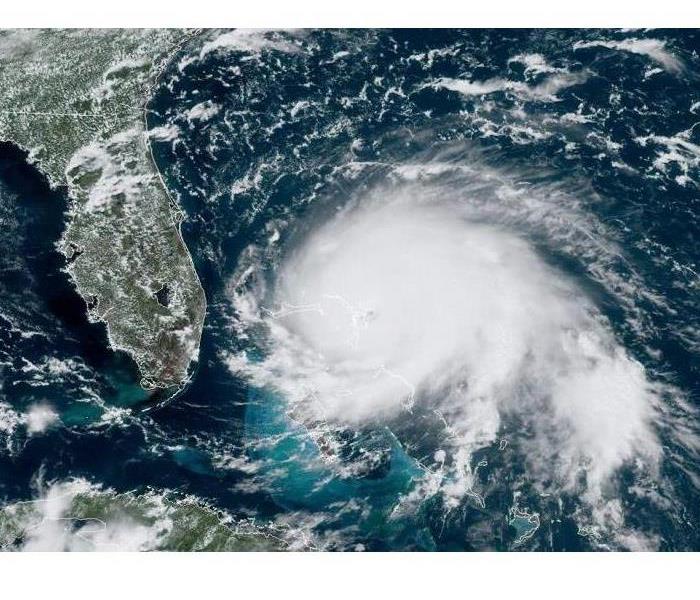 Are you Prepared or Not?
Are you Prepared or Not?
Because weather can be so volatile, especially with the upcoming hurricane season, it’s important be prepared in advance. Here at SERVPRO of North Clay County/Oakleaf/North Middleburg we’ve seen firsthand how destructive storm damage can be, and we want to make sure everyone in this community knows what they can do before, during and after a storm to help protect your family and your property in case of a storm emergency.
Here’s a helpful guide so you can be prepared when a storm is in the forecast:
Before
- Make sure you’re ready with a Disaster Preparation Plan. Determine a meeting place away from your home or commercial building and plan escape routes from each room. Practice the plan with everyone, so there won’t be any question what to do in an emergency.
- Put together an Emergency Supply Kit. Some good items to include are water, non-perishable food, extra medications, a flashlight, batteries, copies of your personal documents, a blanket, a first aid kit, and cash.
- Check that your home or commercial building is in good condition to withstand a strong storm. Check your roof now for loose shingles and make sure your doors, windows, and basement are waterproof.
During
- During a storm, make sure all the windows and doors have been securely shut. Keep away from windows in case the glass should break and shatter. If the storm is severe, you may want to stay in the basement if you have one, or an interior room.
- If you go outside, be careful of moving water, because just a few inches of rapidly flowing water can be enough to sweep a person off their feet. If you can, try to stay on higher ground and keep away from low lying areas where deep flooding is more likely.
After
- Once the storm is over, make sure everyone is ok and start to check your property for any damage. Don’t forget the maxim “Safety First” as flooding can cause potential hazards, including risks of falling, contamination, and electrocution.
- Make a list of any lost or damaged items, and take photos to document the extent of the damage.
Don’t forget, any storm can happen suddenly, so now is the best time to plan and act. And, if you do require emergency flood repair or water damage restoration, rest assured that SERVPRO of North Clay County/Oakleaf/North Middleburg located in Orange Park, Florida is always here to help. We’re known for being “faster to any disaster” with the advanced technicians and equipment needed to restore your property so that it’s like new. We can even help you work with your insurance provider. If your located in Middleburg, Oakleaf, MacClenny or Orange Park we are here to help!
How to Prepare for Hurricane Season
5/12/2021 (Permalink)
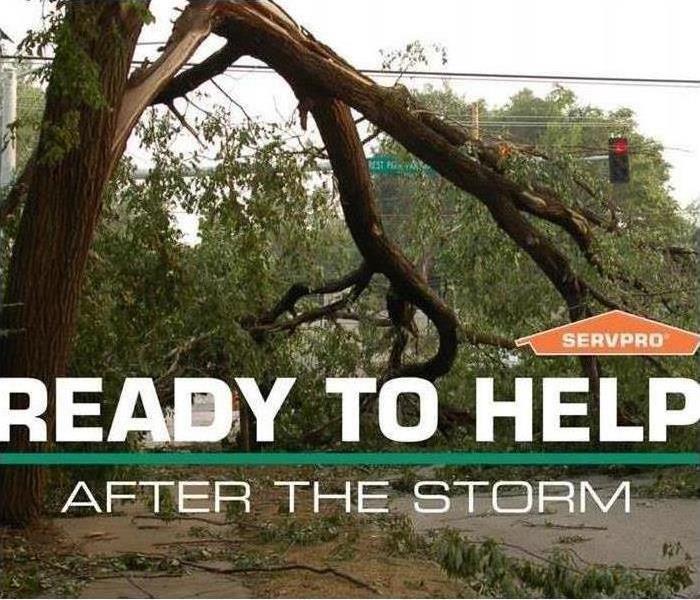 HERE TO HELP AFTER THE STORM
HERE TO HELP AFTER THE STORM
Officially, the hurricane season starts on June 1 and ends on November 30. However, in the Eastern Caribbean and along the US East Coast, the peak season runs mainly from mid-August through mid-September. Hurricanes are powerful and unpredictable storms that can cause immense damages in their path. For you to stay safe and protect your property during a hurricane, preparedness is critical. Check out how to prepare for hurricanes and what to do during and after one.
Hurricane Preparedness Tips
Before the Hurricane
- Create an emergency kit. FEMA recommends packing the following items in your emergency kit:
- Water for drinking and sanitation to last at least three days;
- Non-perishable food for at least three days;
- Hand crank or battery-powered radio (tuned in to NOAA Weather Radio), as well as spare batteries;
- Flashlight with extra batteries;
- First aid kit;
- Whistle to call for help;
- Dust mask, plastic sheeting, and duct-tape for shelter making;
- Moist towelettes and garbage bags for sanitation;
- Pliers or wrench to turn off utilities;
- Can opener;
- Local maps;
- Cell phone with an extra charger.
- Learn your area’s flooding risk and community hurricane evacuation routes. Know the geographical location you live in.
- Create a family evacuation plan. Determine a meeting place for your family and routes to get there. Plan how to get in touch with your family if separated. Plan where you’ll go if you must evacuate, such as a shelter.
- If you don’t have flood insurance, get one now. Regular homeowners insurance policies don’t cover flood damage.
- Find out whether your property is flood-prone due to its elevation level.
- Store copies of important documents, such as proof of ownership of any property in your emergency kit.
- Back up the data on your electronic devices to ensure it’s secure if your computer or other devices are damaged during the hurricane.
Secure Your Property:
- Secure your roof. Make your roofing and frames stronger by installing reinforcements, such as straps or clips. Also, secure loose shingles with heavy-duty adhesive and seal around your home’s chimney or vent pipes to keep water out.
- Maintain gutters and downspouts. Clean your gutters and downspouts regularly to prevent clogs. These could cause water damage to your home when the rain starts to pour. Also, ensure your gutters are firm and not sagging.
- Secure your windows. Strong winds can shatter your windows, leaving your home vulnerable. The best way to secure your windows is to install permanent storm shutters made of steel, aluminum, and other materials. Installing plywood is also a good defense for your windows. However, avoid taping as it doesn’t prevent the glass from breaking.
- Caulk your home. Caulking is a fast way to waterproof your house and reinforce vulnerable areas. Caulk around your windows and doors, the edges of your house, and around chimneys and other roof penetrations.
- Insulate the outside first floor walls with rigid foam or install plastic sheeting. It won’t stop all the water from getting in, but the insulation will keep out most of the silt.
- Reinforce your garage. To make it withstand powerful winds, secure your garage door with a brace kit rated for storm and hurricane winds. Other ways to strengthen your garage door are installing a metal post system or covering the door with metal panels, fabric screen, or 5/8-inch plywood.
- Trim trees and shrubs. Loose branches in your yard (and neighborhood) could be struck by powerful winds during a storm, damaging your house. So cut those dead or loose branches to safeguard your property.
- Secure loose objects. Your yard may also host things that could become projectiles in high winds. Tie-down and secure anything that could be swept up by winds, such as potted plants, lawn furniture, and dog houses. When a storm is imminent, bring light objects inside.
- Protect appliances from power outages. While you should unplug electrical devices during a powerful storm, it’s also ideal to purchase a surge protector. It prevents damage to your devices in case the power goes out.
- Move valuables to a higher floor. As electronics and appliances are susceptible to water damage, move them to a higher floor. If you can’t, at least raise them off the floor on concrete blocks.
- Use sandbags when a storm is hours from arriving. Pile up sandbags at least two feet high as an efficient barricade against floodwaters. If you don’t have sandbags, place heavy-duty garbage bags – filled one-third of the way with water – around your house doors.
- When a storm is hours from arriving:
- Ensure your car is in good working condition and fill up the gas tank. If you’re going to evacuate, stock your vehicle with emergency supplies.
- Charge your cell phone to have a full battery if the power goes out.
- Turn your refrigerator to the coldest setting so that food lasts longer during a power outage.
- Be alert for the latest weather updates and emergency instructions.
Polar Vortex 2021 - TEXAS - ONE TEAM
2/25/2021 (Permalink)
 Trailer of drying equipment headed to Texas - ONE TEAM
Trailer of drying equipment headed to Texas - ONE TEAM
When the local franchises receive over 24000 phone calls from customers experiencing water losses due to frozen pipes bursting in their homes and businesses it is a call to action for franchises not affected! We received this call on Tuesday evening the 16th and dispersed a crew on Thursday the 18th at 5:30 am.
Our 2nd crew headed towards Texas loaded down with more drying equipment and supplies on the 23rd. The amazing thing about SERVPRO you ask?? We are all ONE TEAM when the time comes and the need arises!
So very thankful to be able to travel and assist the customers located in Texas that have damage to their homes or businesses. Thankful for our wonderful staff that continues to shine day after day helping customers get through a difficult time.
We strive to treat each customer we serve in the highest regard and their home or business as if it were our very own.
You can trust us to the same for you! ONE TEAM!
Busted pipes can bust the holiday season
11/20/2020 (Permalink)
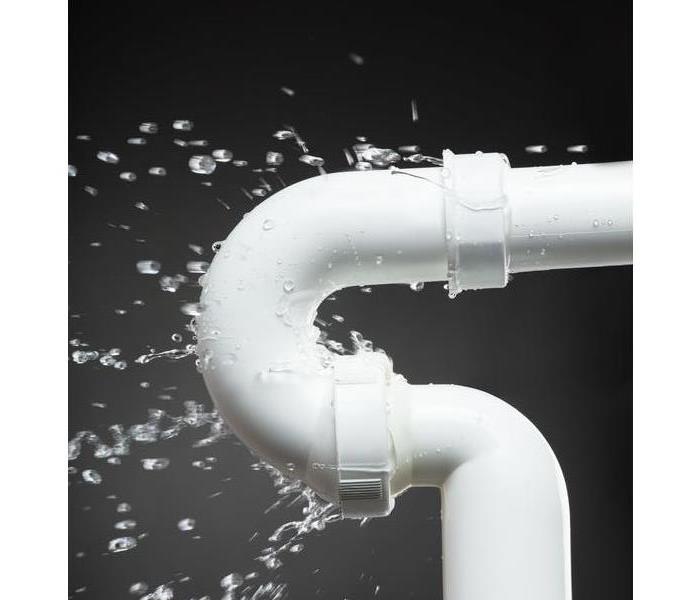 Pipe leaking
Pipe leaking
When temperatures plummet, the risk of your pipes freezing and bursting skyrockets. In fact, burst pipes are one of the most common causes of property damage during frigid weather and can cause thousands in water damage—easily $5,000 or more, according to the Insurance Institute for Business and Home Safety.
The pipes most at risk are those in unheated interior spaces such as basements, attics, and garages. But even pipes running through cabinets or exterior walls can freeze. The good news is there are some simple things you can do to keep your water running and your house dry.
“Pipe insulation can cost as little as 50 cents per linear foot at your local hardware store,” says Susan Millerick, IBHS spokeswoman. “So for not much more than the cost of the aspirin you’d need, you can avoid the headaches of cleanup, loss of precious keepsakes, and the cost of your insurance deductible.” Use the pipe insulation liberally to protect any vulnerable pipes.
How to Beat the Freeze
Once the temperature starts dropping outside, you should take measures inside to keep your pipes warm and water running. Research conducted by the Building Research Council at the University of Illinois shows that the “temperature alert threshold” is 20° F, especially if you have uninsulated pipes running through an uninsulated space.
Some of the steps experts recommend may go against your better instincts of conserving water and heat, but the extra expense is nothing compared with a hefty repair bill. Here’s what to do:
Keep garage doors closed, especially if there are water supply lines in the garage.
Open kitchen and bathroom cabinet doors to allow warmer air to circulate around the plumbing, especially if your sinks are on an exterior wall. (If you have small children, be sure to remove any harmful cleaners and household chemicals.)
Let the cold water drip from a faucet served by exposed pipes. Running water through the pipe—even at a trickle—helps prevent pipes from freezing.
Keep the thermostat set to the same temperature during day and night. Again, during a cold snap is not the time to set back the thermostat at night to save a few bucks on your heating bill.
If you plan to be away during cold weather, leave the heat on in your home, set to a temperature no lower than 55° F.
For the long term, add insulation to attics, basements, and crawl spaces. Insulation will maintain higher temperatures in those areas. And to prevent drafts, seal cracks and openings around windows, doors, and at sill plates, where the house rests on its foundation.
How to Thaw Frozen Pipes
If you turn on a faucet and only a trickle comes out, you may well have a frozen pipe. “If you suspect the pipes are frozen, be careful when thawing them out because if the pipe has already burst, the water will come flowing out and flood your home,” says John Galeotafiore, who oversees Consumer Reports’ testing of home products and power gear.
If a pipe has broken, turn off the water at the main shutoff valve, which is usually at the water meter or where the main line enters the house. If the water is still running and no pipes have burst, you can take the following steps. (Of course, if you suspect a more serious problem, call a plumber.)
Turn on the faucet. As you heat the frozen pipe and the ice plug begins to melt, you want the water to be able to flow through. Running water through the pipe, as cold as it is, will help melt ice in the pipe.
Apply heat to the section of pipe using an electric heating pad wrapped around the pipe, an electric hair dryer, or a portable space heater (kept away from flammable materials), or by wrapping pipes with towels soaked in hot water. As tempting as it may be, do not use a blowtorch, a kerosene or propane heater, a charcoal stove, or any device with an open flame; the high heat can damage the pipes or even start a fire.
Apply heat until full water pressure is restored. Check all other faucets in your home to see whether you have additional frozen pipes. If one pipe freezes, others may freeze, too.
Call a licensed plumber if you are unable to locate the frozen area, if the frozen area is not accessible, or if you cannot thaw the pipe.
If you have any questions or run into any issues with busted pipes, frozen or not, feel free to give our office a call.
Build a Sandbag and how to use it
8/10/2020 (Permalink)
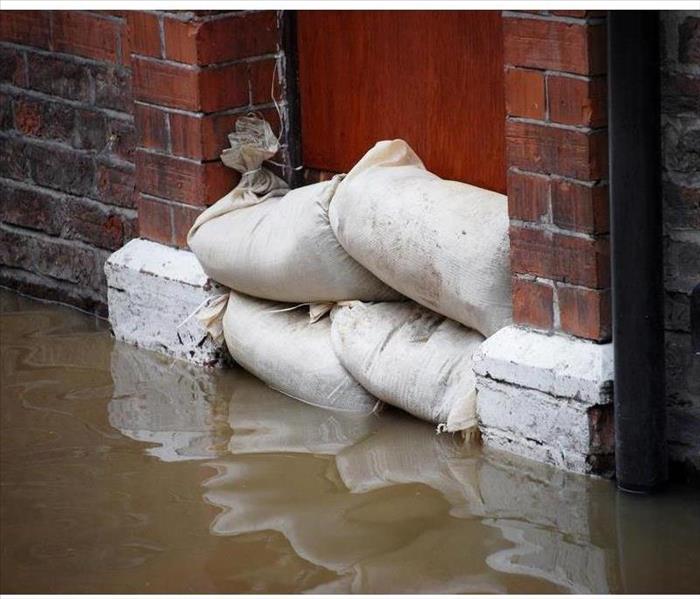 Sandbags in doorway
Sandbags in doorway
Where can I get sandbags from?
Sandbags can be purchased from some local hardware stores or landscaping suppliers. During times of flood and storm, quantities may be distributed by your local Council. Contact your local Council or visit their web site for further information.
When significant flooding is occurring, sandbags maybe in limited supply and may only be issued by the Council or State Emergency Service (SES) on a case by case basis. So be prepared and purchase/prepare your own sandbags prior to, or when aware of an impending flood event.
Self-inflating sandbags are ready-to-use sandbags that don’t require filling are a light weight alternative to traditional sandbags. They will self-inflate when they come into contact with water and can be stored a long time. Self-inflating sandbags can be purchased from some local hardware stores or landscaping suppliers.
How do I fill the sandbag?
It is preferable that you only use sand to fill the bags. Soil, clay, gravel or a mixture of these is not usually recommended.
Sandbags only need to be filled to 2/3 full.
Do not over fill as they will be too heavy to carry. A filled sandbag can weigh 15-20 kilograms.
Do not tie the top of the bag. The top of the bag may be tied for transport purposes only.
Where do I need to put the sandbags?
For most buildings to reduce the impact of flooding, sandbags should be placed over floor wastes and drains (e.g. laundry, shower and bath) to prevent backflow of grey water entering. Sandbags should also be used in front of doorways / roller doors and brickwork vents.
Most standard homes and buildings on a concrete slab can be protected with less than 25 sandbags.
It is not always necessary to place a sandbag wall around your whole building to provide protection. This may only be necessary if it is on stumps or constructed of materials such as timber or fibro sheeting. Before building a sandbag wall consideration should be given to how you would remove floodwater that could become trapped between the sandbag wall and your building. (e.g. pump, siphon or bailing bucket).
If you have any further questions, call SERVPRO of North Clay County/Oakleaf/North Middleburg.
Storm season is upon us
6/16/2020 (Permalink)
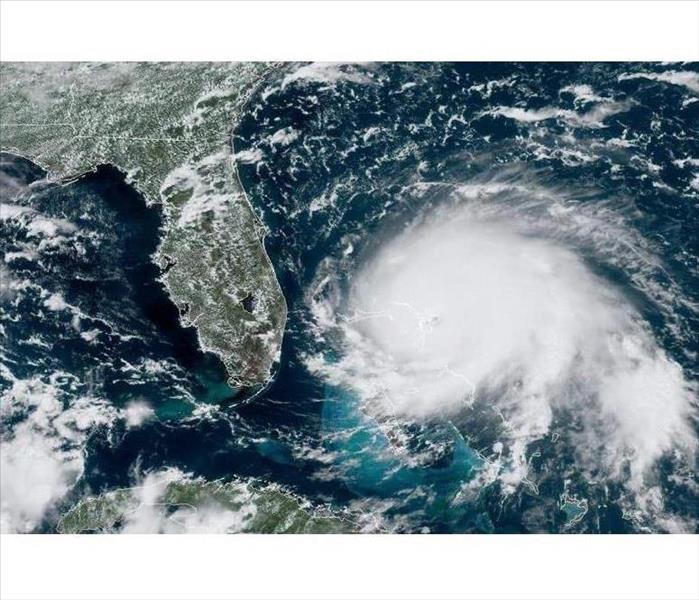 Hurricane
Hurricane
The Essential Guide to Hurricane Preparedness
Our team at SERVPRO of North Clay County/Oakleaf/Middleburg want to make sure that you have a place you can go to if you have any questions as far as Hurricane season and storms are concerned. Each year hurricane season begins on June 1st and lasts 5 months, with storms typically peaking in August and September. As with every hurricane season regardless of forecast, knowing the essentials of how to prepare could truly be a life saver.
Hurricane Knowledge
First, know your hurricane facts and understand common terms used during hurricane forecasts. Storm conditions can vary on the intensity, size and even the angle which the tropical cyclone approaches your area, so it is vital you understand what the forecasters and news reporters are telling you.
Tropical Depressions are cyclones with winds of 38 mph. Tropical Storms vary in wind speeds from 39-73 mph while Hurricanes have winds 74 mph and greater. Typically the upper right quadrant of the storm (the center wrapping around the eye) is the most intense portion of the storm. The greatest threats are damaging winds, storm surge and flooding. This is in part why Hurricane Katrina was so catastrophic when bringing up to 28 foot storm surges onto the Louisiana and Mississippi coastlines.
Here are some important terms you may hear:
- Tropical Storm Watch: Tropical storm conditions are possible in the area.
- Hurricane Watch: Hurricane conditions are possible in the area.
Watches are issued 48 hours in advance of the anticipated onset of tropical storm force winds. - Tropical Storm Warning: Tropical storm conditions are expected in the area.
- Hurricane Warning: Hurricane conditions are expected in the area.
Warnings are issued 36 hours in advance of tropical storm force winds. - Eye: Clear, sometimes well-defined center of the storm with calmer conditions.
- Eye Wall: Surrounding the eye, contains some of the most severe weather of the storm with the highest wind speed and largest precipitation.
- Rain Bands: Bands coming off the cyclone that produce severe weather conditions such as heavy rain, wind and tornadoes.
- Storm Surge: An often underestimated and deadly result of ocean water swelling as a result of a landfalling storm, and quickly flooding coastal and sometimes areas further inland.
During a watch, prepare your home and evacuation plan in case a warning is issued. During a warning, carefully follow the directions of officials, and immediately leave the area if they advise it. In the event of an Extreme Wind Warning/Advisory, which means that extreme sustained winds of 115 mph or greater are expected to begin within an hour, immediately take shelter in the interior portion of a well-built structure.
Hurricane Forecasts
Predicting a tropical cyclone's path can be challenging; there are many global and local factors that come into play. The storm's size and path can directly influence what sort of wind patterns guide, enhance or hinder its growth, and vice versa! Forecasters have computers that take huge amounts of data and try to predict where the storm will go and usually can calculate 2-3 days out fairly accurately. This is where you hear the terms computer models and spaghetti models being used. Generally the forecast track or path is given with the average consensus of these models. The National Hurricane Center has the most up-to-date information on tropical cyclone developments, forecasts and weather alerts, discussions analyzing the data and more. http://www.nhc.noaa.gov/
If you have any questions feel free to give us a call and we will more then happy to help any way that we can.
First 2020 Hurricane season action - Tropical Storm Cristobal
6/8/2020 (Permalink)
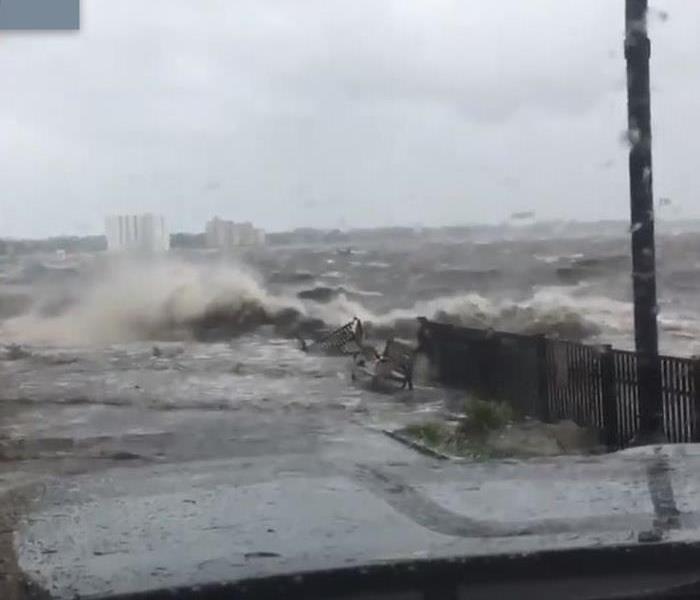 Flash Flood in Jacksonville
Flash Flood in Jacksonville
SERVPRO of North Clay County/Oakleaf/Middleburg is here to assist with any issues that may arise from the first Tropical event to make US landfall in 2020, Cristobal. "The earliest calendar year landfalling named storm in Louisiana on record (since 1851) is Tropical Storm Arlene on May 30, 1959," Phil Klotzbach, a meteorologist at Colorado State University, said on Twitter. "The 2nd earliest landfalling named storms in LA are unnamed tropical storms in 1912 & 1956 on June 13." That means Cristobal is thesecond-earliest named storm to make landfall in Louisiana since records have been kept, he said. Our local area suffered through quite a downpour of rain and some severe flash flooding that closed down streets and also some parts of I-10. If you have any issues stemming from the flooding, feel free to give us a call at 904-861-8870 and we will assist to make it "Like it never even happened."
Severe Spring Weather Tips
3/3/2020 (Permalink)
 Be prepared for whatever spring brings.
Be prepared for whatever spring brings.
While spring brings the promise of warm weather and longer days, it also brings a variety of conditions that can include heavy rains and severe weather, which can increase your flood risk. Take action to protect yourself, your family, and your business—before a weather event occurs and it’s too late.
April marks the start of the rainy season. Spring storms can bring several inches of rain in only a matter of hours or there can be consistent rainfall for days. These heavy rains can lead to severe flooding by over-saturating the ground, overfilling storm drains, or rivers spilling over their banks.
As one of the most common hazards in the United States, it’s important we prepare for the potential disaster that flooding can cause. Even if you feel you live in a community with a low risk of flooding, remember that anywhere it rains, it can flood. Just because you haven’t experienced a flood in the past, doesn’t mean you won’t in the future.
In order help prepare you for the possibility of a flood, we offer you these tips:
- Build an emergency kit and make a family communications plan
- Avoid building in a floodplain unless you elevate and reinforce your home
- Elevate the furnace, water heater and electric panel in your home if you live in an area that has a high flood risk
- Install check-valves to prevent flood water from backing up into the drains of your home
- Seal basement walls and floor with waterproofing compounds to prevent seepage through cracks
- Always keep your gutters and downspouts clean to allow water to flow freely
- Prepare a flood evacuation plan
- Know how to safely shut-off utilities
- Keep insurance and vital records in a water-proof box
- Have a portable radio to listen for important current information
When your home sustains water damage from flooding, you should call SERVPRO of North Clay County/Oakleaf/North Middleburg immediately. SERVPRO of North Clay County/Oakleaf/North Middleburg professionals have the expertise to prevent or mitigate the devastating effects that water damage can have.
SERVPRO of North Clay County/Oakleaf/North Middleburg covering the West Side Orange Park has the equipment and experience necessary to handle the most challenging water damage and removal situations and we are available around-the-clock. Call us at (904) 861-8870, and we’ll return your home back to normal, "Like it never even happened."
Storms or Cleaning, We are here for you!
2/14/2020 (Permalink)
 We are here for you when you need us!
We are here for you when you need us!
SERVPRO Storm Response
The team here at SERVPRO of North Clay County/Oakleaf/North Middleburg is ready for whatever happens, no matter the time, night or day. When it comes to fire & water damage, our professionals work endlessly to make sure our customers are happy and that we walk them through each step of the cleaning process.
We're Highly Trained Storm Damage Specialists
As leaders in the storm and water damage industry, we have advanced training and expertise, not to mention a tremendous amount of hands-on experience. We use this training and experience to quickly dry your home and restore it back to pre-storm condition.
We're Quick to Any Size Disaster
When a storm hits your home or business, you need help immediately. Our quick response will help prevent secondary damage and help reduce restoration costs.
We Have the Resources to Handle Storms and Disasters
We can access the resources and personnel of 1,700 Franchises to handle major storms and disasters. We also have access to special Disaster Recovery Teams strategically located throughout the country to respond to catastrophic storms and events.
Locally Owned and Operated
SERVPRO of North Clay County/Oakleaf/North Middleburg is locally owned and operated, so we are part of this community too. Westside Orange Park is where we grew up and went to school. When you have a storm event or flooding emergency, we are in the area and ready to help.
Have Storm or Flood Damage?
Call SERVPRO of North Clay County/Oakleaf/North Middleburg today (904)861-8870



 24/7 Emergency Service
24/7 Emergency Service















